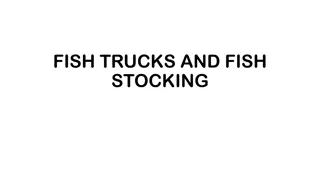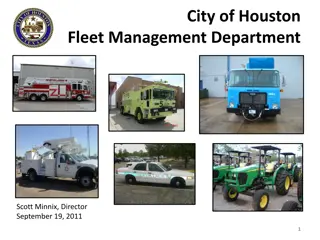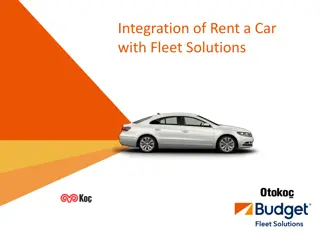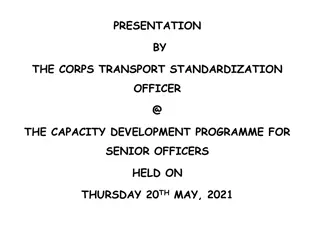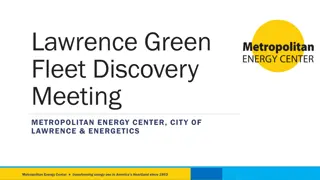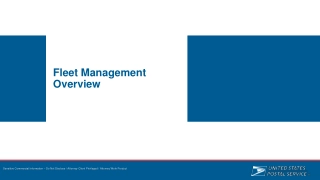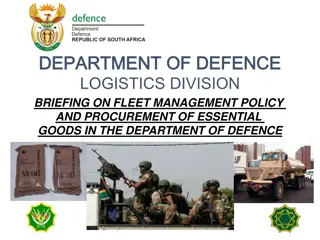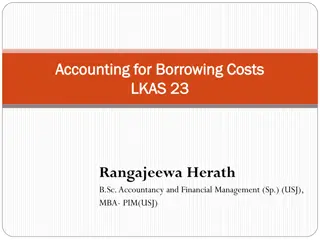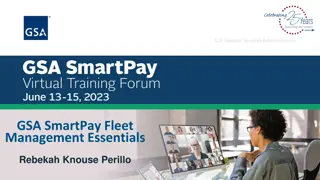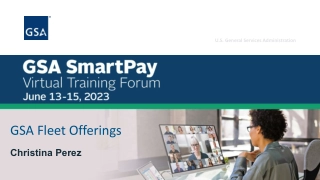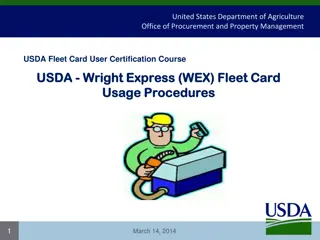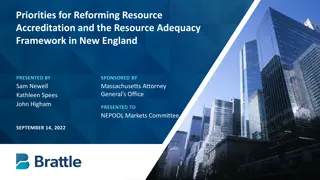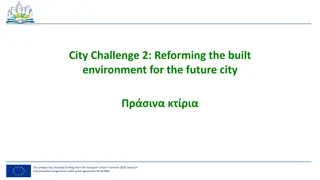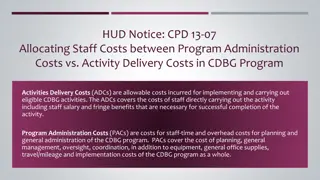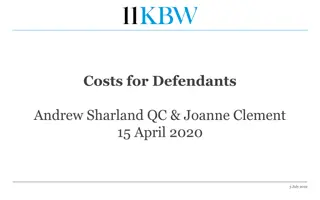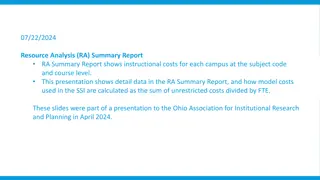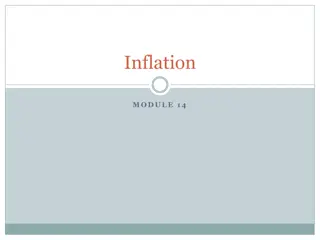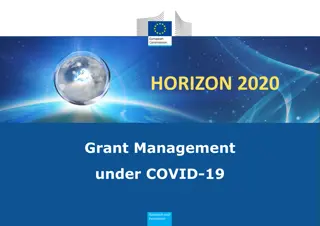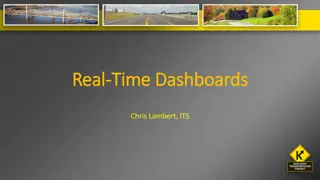The Economic Costs of Not Reforming Public Fleet Management
This presentation discusses the economic arguments for reforms in public fleet management, emphasizing the key economic and financial management reforms needed. It highlights the costs associated with managing the public fleet and the benefits of implementing reform strategies to enhance efficiency, service quality, and overall economic growth.
Download Presentation

Please find below an Image/Link to download the presentation.
The content on the website is provided AS IS for your information and personal use only. It may not be sold, licensed, or shared on other websites without obtaining consent from the author. Download presentation by click this link. If you encounter any issues during the download, it is possible that the publisher has removed the file from their server.
E N D
Presentation Transcript
ECONOMIC COSTS OF NOT REFORMING THE PUBLIC SECTOR: THE CASE OF PUBLIC FLEET MANAGEMENT 2013 ECAMA ANNUAL CONFERENCE PETER NGOMA, Ph.D MALAWI INSTITUTE OF MANAGEMENT VICE PRESIDENT, ECAMA
PRESENTATION OUTLINE ECONOMIC ARGUMENTS FOR REFORMS KEY ECONOMIC AND FINANCIAL MANAGEMENT REFORMS PUBLIC FLEET MANAGEMENT COSTS OF MANAGING THE PUBLIC FLEET VEHICLE OWNERSHIP SCHEME AS A REFORM CONCLUSIONS
ECONOMIC ARGUMENTS FOR REFORMS ERP MGDS II ( 6% REAL GDP GROWTH PER YEAR) VISION 2020 (MIDDLE INCOME COUNTRY, PER CAPITA INCOME OF US$1000, 25% GDP FROM MANUFACTURING) ECONOMIC GROWTH ECONOMIC GAINS Economy Performance Effectiveness/ Productivity High Service Quality Efficiency Competition
KEY ECONOMIC AND FINANCIAL MANAGEMENT REFORMS Parastatal policy and legal framework Asset management system in public service Stores and supplies management Public service pension scheme Consolidation of IFMIS Local development management Budget management Auditing system
PUBLIC FLEET MANAGEMENT VERIFIED PUBLIC FLEET INVENTORY IN MDAs BODY TYPE RUNNER Station Wagon 701 Saloon 201 Twin Cab 704 Single Cab 129 TOTAL 1,735 BOARD OFF TOTAL 78 17 102 37 234 779 218 806 166 1,969 All types Source: Ministry of Finance 2,748 355 3,103 Excludes parastatals, MDF, police - mainly central government MDAs Station wagons Include Land Cruisers, Prados, Pajeros, etc Saloon Include Mercedes Benz, Camry, etc All types Include Ambulances, Tractors. Motorcycles, Graders, Lorries, Buses, Minibuses, etc
PUBLIC FLEET MANAGEMENT SYSTEM PRE-1994 POST 1994 All procurement by PVHO Procurement decentralized All maintenance by PVHO Maintenance decentralized All insurance by PVHO Insurance decentralized MDAs actively hiring from PVHO Minimal hiring from PVHO MDAs had budget line for hiring No budget line for hiring vehicles from PVHO vehicles from PVHO etc etc
COSTS OF MANAGING THE PUBLIC FLEET 50.00 40.00 Million (US$) 30.00 20.00 10.00 - 2009/10 31.80 2010/11 32.06 2011/12 2012/13 Audited (US$) Revised (US$) 25.71 37.27 MK (billion) 4.8 4.5 4.0 9.2 Recurrent budget only excludes development budget Motor vehicle running expenses budget line only excludes new purchases Includes fuel and lubricants (71%); maintenance (23%); insurance (6%) Excludes parastatal organisations
STAFF COMPLIMENT IN MDAs Grade Established Filled Vacancy Rate 47% 9% 38% 42% S2 B C D E 64 66 241 799 34 60 P2-P4 149 463 P5-P7 F G H I J K 1,565 2,857 5,301 13,277 13,146 32,373 69,689 763 1,629 1,558 6,283 7,689 18,477 37,105 51% 43% 71% 53% 42% 43% 47% EO/PO-P8 TOTAL Source: DHRMD (2009/10 FY) Officers entitled to vehicles (station wagon/saloon) about 706 Officers entitled to 500 liters of fuel per month for local running about 94 Officer entitled to 250 liters per month for local running about 612 Entitled to fuel for performing duties outside office. Vehicle maintenance paid for by line MDA
HOME-OFFICE VEHICLE USE Public vehicle may be used during holidays and weekends official or duties 100% on unofficial 80% % Public Vehicle use 60% 40% 20% Sunday Saturday Friday Thursday 0% Wednesday B-C (S2) D-E (P2-P4) Tuesday F-G (P5-P7) H-K (EO-P8) SS (HR) Monday SS (Admin) SS (Accounts) SS (Stores) SS (Driver) Cadre/Grade
ESTIMATED COST OF PUBLIC VEHICLE MISUSE 2011/12 10 52 53 250 365 68% 32% 2012/13 10 52 52 250 364 69% 31% Holidays Saturdays Sundays Working days Total % Work days % Off-days Total running expenses (MK billion) MK 4.5 billion MK 4.8 billion MK 4.0 billion Fuel & Maintenance costs (94%) MK 4.2 billion MK 4.5 billion MK 3.8 billion Off-days costs MK? (depending on your assumptions) FY 2009/10 2010/11 2011/12 2012/13 MK 9.2 billion MK 8.6 billion
AVOIDABLE COSTS ON FLEET MANAGEMENT VEHICLE MISUSE MAINTENANCE COSTS FUEL MISUSE THEFT OF SPARE PARTS; DRIVERS COSTS;
VEHICLE OWNERSHIP SCHEME AS A REFORM Curtails growing size of public fleet; Optimizes utilization of public fleet; Reduces government burden of fleet management; Eases transportation problem of public servants (P5 and below); Source of motivation to public servants; Increases efficiency of public servants; Introduces equity and transparency in allocation of public resources.
THE CASE OF RWANDA Targeted all public officers Vehicles bought through loans granted by commercial banks Loan servicing up to a third of one s salary Employees eligible to maximum loan: 3000 5000 cc for high ranking officials 2500 3000 cc for ministers and equivalent 1500 2500 cc for other officials Vehicles exempted of import taxes and duties Comprehensive insurance throughout loan period Government contributes to operating costs for official purposes Field travel (outside 30 km from office) either through hire or public transport specified number of days per month Government only kept vehicles for: Political officials, commanders, generals Mayors Ambassadors State protocol Military, police and prisons operations Ambulances Salary reforms!!! Estimated average saving of about 35%
IN MALAWI THE CASE OF PRIVATE SECTOR Employer guaranteed vehicle loan (private property ensuring prudent management) Running expenses covered fuel, maintenance, etc Insurance coverage Use for both official and private business Driver by choice (costs reduced) High efficiency High productivity
POTENTIAL VEHICLES FOR OWNERSHIP SCHEME IN MDAs BODY TYPE RUNNERS MINISTRY PVHO % MINISTRY % PVHO Station Wagon 701 405 296 58% 42% Saloon 201 78 123 39% 61% Twin Cab 704 381 323 54% 46% Single Cab 129 96 33 74% 26% TOTAL 1,735 960 775 55% 45% All types 2,748 1,539 1,209 56% 44%
WHAT MUST BE RESOLVED TO IMPLEMENT VEHICLE OWNERSHIP SCHEME Lack of incentive to vehicle ownership scheme: Age of senior officers Already privileged and subsidized Vehicle type Age of vehicle High initial cost to procure new vehicles: Phased by year Phased by grades Board off Revive PVHO Loan default Job mobility National ID Low salaries Salary reforms Pension reforms
CONCLUSIONS Economic arguments for public sector reform rhetoric are a global phenomenon (Pollitt et al. 2004; Smullen 2010; Van Thiel 2004). To get a clear idea of the implications of reforms, there is a need for detailed ECONOMIC ANALYSIS between the nature of reforms and the effects.
REFLECTION There is an ocean of studies of the application of New Public Management ideas but only a modest sea of works that offer direct empirical economic analysis and no more than a small pond that convincingly connect specific reforms to particular economic outcomes


